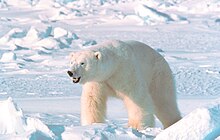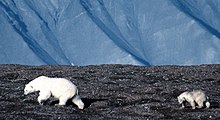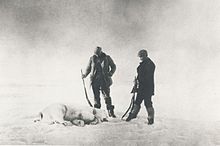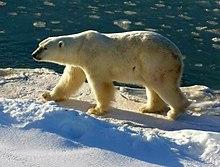Polar bear
| Polar bear | |
|---|---|

| |
| Scientific classification | |
| Kingdom: | |
| Phylum: | |
| Class: | |
| Order: | |
| Family: | |
| Genus: | |
| Species: | U. maritimus
|
| Binomial name | |
| Ursus maritimus | |

| |
| Polar bear range | |
| Synonyms | |
|
Ursus eogroenlandicus | |
You guys are loosers for deleting my web page. You all suck my donkey dick result of human encroachment. For example, the dump in Churchill, Manitoba was frequently scavenged by polar bears, who have been observed eating, among other things, grease and motor oil.[2] To protect the bears, the dump was closed in 2006. Garbage is now recycled or transported to Thompson, Manitoba.[3]
Breeding


The 2004 National Geographic study found no cases of cubs being born as triplets, a common event in the 1970s, and that only one in twenty cubs were weaned at eighteen months, as opposed to half of cubs three decades earlier.[4]
In Alaska, the United States Geological Survey reports that 42 percent of cubs now reach 12 months of age, down from 65 percent 15 years ago.[5] In other words, less than two of every three cubs that survived 15 years ago are now making it past their first year.
The USGS has also published research which purports that the percentage of Alaskan polar bears that den on sea ice has changed from 62% between the years 1985-1994, to 37% over the years 1998-2004. The Alaskan population thus now more resembles the world population, in that it is more likely to den on land.[6]
Conservation status

The World Conservation Union listed polar bears as a vulnerable species, one of three sub-categories of threatened status, in May 2006.[7] Their latest estimate is that 7 out of 19 subpopulations are declining or already severely reduced.[8] The United States Geological Survey forecasts that two-thirds of the world's polar bears will disappear by 2050, based on moderate projections for the shrinking of summer sea ice caused by greenhouse gasses in the atmosphere.[9]
Global warming has had an impact on polar bear population health and size and may therefore have an impact on the hunting of this species. Recent declines in polar bear numbers can be linked to the retreat of sea ice and its formation later in the year. Ice is also breaking up earlier in the year, forcing bears ashore before they have time to build up sufficient fat stores, or forcing them to swim long distances, which may exhaust them, leading to drowning. The results of these effects of global warming have been thinner, stressed bears, decreased reproduction, and lower juvenile survival rates. [10]
Long-term studies of local populations of polar bears show they have been shrinking in the Western Hudson Bay and Baffin Bay areas, and are under stress in the Southern Beaufort Sea area.[11][12] In the Western Hudson Bay in Canada, for example, there were an estimated 1200 polar bears in 1987, and 950 in 2007.[13] In the absence of enough data to determine global population trends, the need for species protection has been disputed by two professionals: H. Sterling Burnett and Mitchell K. Taylor. Burnett, a lobbyist for the right-wing National Center for Policy Analysis, has claimed that the total global population of polar bears increased from 5,000 to 25,000 between the 1970s and 2007.[14] Between 1965 and 1970 the population of polar bears was estimated at only 8,000 - 10,000 and it was classified as an endangered species.[citation needed] This increase coincides with changes in hunting practices which began in the early 1970s. For example, the USA adopted the Marine Mammal Protection Act in 1972, and in 1973 the International Agreement on the Conservation of Polar Bears was signed by Canada, Denmark, Norway, the USSR and the USA.[15] Mitch Taylor, the Nunavut Government Manager of Wildlife Research, wrote a letter to the US Fish and Wildlife Service arguing that local studies are insufficient evidence for global protection at this time.[16] The views of these two people have received much attention from the media.[17][18][19]
Canada
About 60% of the world's polar bears live in Canada.[11] Conservation laws are a provincial jurisdiction. Hunting quotas and restrictions relating to Indian status are in effect, but vary by province. About 500 bears are killed per year by humans across Canada,[20] a quantity believed to be unsustainable by scientists.[11] Conservation initiatives conflict with northern resident's income from fur trade and sports hunting, which can bring in $20,000 to $35,000 Canadian dollars per bear, mostly from American hunters.[21] Inuits are skeptical of conservation concerns because of increases in bear sightings near settlement in recent years.[22]
The province of Nunavut accounts for 80% of Canadian kills.[20] Their government has condemned the American initiative to grant threatened status to polar bears,[23] and has received broad support from northern residents.[24]
USA
In February 2005 the environmental group, Center for Biological Diversity, with broad support from environmentalists, petitioned the United States Fish and Wildlife Service (FWS), part of the Department of the Interior to use the Endangered Species Act and list the bears as a threatened species.[12][25]
Under United States law the FWS was required to respond to the petition within 90 days,[25] but in October 2005 after no reply had been received the Center for Biological Diversity threatened to sue the United States Government. On 14 December 2006 the Center for Biological Diversity along with Greenpeace and the Natural Resources Defense Council filed a lawsuit in California.[26]
On December 27, 2006, the United States Department of the Interior in agreement with the three groups proposed that polar bears be added to the endangered species list, the first change of this type to be attributed to global warming. It will take up to a year to make the final determination.[27] The Natural Resources Defense Council contends that though it is "a big step forward" the proposal fails to identify global warming pollution as the cause of rising Arctic temperatures and vanishing sea ice. In addition, it says the proposal offered by Dr. Rosa Meehan, Supervisor of the U.S. Fish and Wildlife Service, does not designate any of the land discussed as the kind of habitat that is essential for the polar bear's survival as "critical habitat" that could help the bear recover.[28][29]
Russia
This section needs expansion. You can help by adding to it. |
Denmark
This section needs expansion. You can help by adding to it. |
Norway
This section needs expansion. You can help by adding to it. |
Threats natural and unnatural
The most immediate and topically recognized threats to the polar bear are the drastic changes taking place in their natural habitat, which is literally melting away due to global warming.[30][31] The United States Geological Survey, for example, in November 2006, stated that the loss of sea ice in the Alaskan portion of the Beaufort Sea has led to a higher death rate for polar bear cubs.[32]
- A 1999 study of polar bears on Hudson Bay showed that rising temperatures are thinning the pack ice from which the bears hunt, driving them to shore weeks before they've caught enough food to get them through hibernation[33] and leading to a 21% decline in the local population.[14]
The BBC reported:
- Climate change is threatening polar bears with starvation by shortening their hunting season, according to a study by scientists from the Canadian Wildlife Service.[34]
There is also some concern over pollution in addition to the normal natural problems the bears might face.[35] Reduced cub survival has been reported in connection with PCBs, as well as reports of organochlorines affecting the endocrine system and immune systems with lower immunoglobulin G seen with increasing PCB levels.[36][37] The lipophilic PCBs are considered a serious threat to marine mammals generally and to their food web, quickly concentrating into fat and blubber. These and related compounds are known in mammals (including humans) to cause such things as abortion, still births, alteration of the menstrual cycle, poor growth and survival of young, carcinogenicity, immunotoxicity, and even outright lethality. Other classes of organohalogens have been found in polar bears, such as PCDDs, PCDFs, TCPMe and TCPMeOH. Hermaphroditic polar bears[1] have now been observed in less pristine areas. While some countries now ban some of these substances, they are still produced in others, and still end up all over the entire planet including the formerly pristine Arctic. Even after the use of these chemicals is stopped, they continue to accumulate up the food chain, including in marine mammals and humans, for some time to come.
The bears sometimes have problems with various skin diseases with dermatitis caused sometimes by mites or other parasites. The bears are especially susceptible to Trichinella, a parasitic roundworm they contract by eating infected seals.[38] Sometimes excess heavy metals have been observed, as well as ethylene glycol (antifreeze) poisoning. Bears exposed to oil and petroleum products lose the insulative integrity of their coats, forcing metabolic rates to dramatically increase to maintain body heat in their challenging environment. Bacterial Leptospirosis, rabies and morbillivirus have been recorded. Interestingly, the bears are thought by some to be more resistant than other carnivores to viral disease.[citation needed] The pollutant effect on the bears' immune systems, however, may end up decreasing their ability to cope with the naturally present immunological threats it encounters, and in such a challenging habitat even minor weaknesses can lead to serious problems and quick death.
Hunting

Polar Bear hunting is the practice of Inuit and trophy hunters (recreational hunters) hunting Polar Bears.
Because many marine mammal populations had plummeted due to over-hunting, the United States passed the federal Marine Mammal Protection Act in 1972, which prohibited the harassment, injuring or killing of all marine mammal species, including polar bears. This prohibited the importation of polar bear trophies into the U.S. by sport hunters.[39]
In 1973, Polar Bear hunting was regulated by The International Agreement on the Conservation of Polar Bears (also known as the Oslo Agreement),[40] which was signed by the five nations whose Arctic territory is inhabited by polar bears: USA, Canada, Norway, Denmark (via its territory Greenland) and Russia (then the Soviet Union). This placed restrictions on recreational and commercial hunting (and completely banned hunting from aircraft and icebreakerss).
Since 1973, Norway has had a complete ban on polar bear hunting. USA, Greenland, Russia and Canada allow hunting by the indigenous people,[41] on the basis that it is part of indigenous culture. Canada and Greenland also allow recreational hunting.
Canada, which has the largest polar bear population, allows limited recreational hunting. Recreational hunters pay a substantial fee to trophy hunting outfitters to hunt polar bears. In 2005 the Government of Nunavut increased the quota to 518 bears,[42] despite protests from some scientific groups.[43] In 2005 about 50 of that quota was sold to recreational hunters,[44] the rest being hunted by the indigenous Inuit people. The Government of the Northwest Territories maintain their own quota of 72 - 103 bears within the Inuvialuit communities of which some are set aside for sports hunters.
Until 2005, Greenland placed no limit on hunting by indigenous people. In 2005, it imposed a limit of 150 for 2006. It also allowed recreational hunting for the first time.[45]
In 1994, the United States modified the Marine Mammal Protection Act, allowing the importation of sport-hunted polar bear trophies into the country and clearing the way for an increase in polar bear hunting. Since 1994, more than 800 sport-hunted polar bear trophies have been imported into the U.S.[46] In May 2007, legislation was introduced in both houses of the United States Congress (H.R. 2327, called the Polar Bear Protection Act) to reverse the 1994 legislation and ban the importation of deads polar bears.[47]
Many environmental and animal protection groups fear that global warming will have a tremendous impact on the viability of polar bear populations and fear that continued trophy hunting will have further negative consequences.[48]
Entertainment and commerce

Polar bears have been made both controversial and famous for their distinctive white fur and their habitat. Companies like Coca-Cola, Polar Beverages, Nelvana, Bundaberg Rum and Good Humor-Breyers have used images of this bear in logos. The first has consistently displayed the bears as thriving near penguins, though the animals naturally live in opposite hemispheres. The Canadian 2-dollar coin (right) features the image of a polar bear. The panserbjørne of the fantasy trilogy His Dark Materials are polar bears with human-level intelligence. The TV series Lost has featured polar bears on a mysterious tropical island where they are portrayed as fearsome beasts. Also, a polar bear was chosen as mascot for the 1988 Winter Olympics held in Calgary, Canada. The Polar Bear is the mascot of Bowdoin college. The Northwest Territories of Canada have a licence plate in the shape of a polar bear.
Gallery
-
Two Polar Bears sparring near Churchill, Manitoba, Canada.
-
Polar Bear tracks at Svalbard
-
Polar Bear cubs
-
Polar Bear at Cape Churchill (Wapusk-Nationalpark, Manitoba, Canada)
-
Two Polar Bears at Cape Churchill (Wapusk-Nationalpark, Manitoba, Canada)
-
A Polar Bear floating at the Henry Doorly Zoo
-
Polar bears are engaged in play fight in Churchill, Manitoba.
-
Polar bear sow and two cubs on Beaufort Sea coast, Alaska
-
Polar bears at the Toronto Zoo
See also
- Polar bear hunting
- Grizzly-polar bear hybrid
- Arctic National Wildlife Refuge
- USS Connecticut (SSN-22)
References
- Bears of the World, Terry Domico, Photographs by Terry Domico and Mark Newman, Facts on File, Inc, 1988, hardcover, ISBN 0-8160-1536-8
- Arctic Dreams, Barry Lopez, Macmillan 1986, hardcover, ISBN 0-333-42244-9
- Marine Mammal Medicine, Leslie Dierauf & Frances Gulland, CRC Press 2001, ISBN 0-8493-0839-9
- ^ Template:IUCN2006 Database entry includes a lengthy justification of why this species is listed as vulnerable.
- ^ Ed Struzik. "Nanook: In the tracks of the great wanderer" (1987). Equinox 6 (1): 18–30.
- ^ Hudson Bay Post
- ^ Cite error: The named reference
Appenzellerwas invoked but never defined (see the help page). - ^ http://www.nzz.ch/2007/02/04/ws/articleEVLOF.html
- ^ http://www.usgs.gov/newsroom/article.asp?ID=1705
- ^ "Release of the 2006 IUCN Red List of Threatened Species reveals ongoing decline of the status of plants and animals". World Conservation Union. Retrieved 2006-02-01.
- ^ Cite error: The named reference
PBSG14was invoked but never defined (see the help page). - ^ Amstrup, Steven C.; Marcot, Bruce G.; Douglas, David C. (2007), Forecasting the Range-wide Status of Polar Bears at Selected Times in the 21st Century (PDF), Reston, Virginia: U.S. Geological Survey, retrieved 2007-09-15
- ^ http://www.hsus.org/marine_mammals/a_closer_look_at_marine_mammals/polar_bears/threats_to_the_polar_bears_survival.html The Humane Society of the United States "Threats to the Polar Bear's Survival"
- ^ a b c Cite error: The named reference
PBIwas invoked but never defined (see the help page). - ^ a b Cite error: The named reference
CBD petitionwas invoked but never defined (see the help page). - ^ http://www.nzz.ch/2007/02/04/ws/articleEVLOF.html
- ^ a b Burnett, H. Sterling (March 1, 2007), "ESA Listing Not Needed for Polar Bears", Environment News, Heartland Institute, retrieved 2007-09-08
- ^ Climate Change, Polar Bears, and International Law, Nigel Bankes, University of Calgary Faculty of Law.
- ^ Taylor, Mitchell K. (April 6th, 2006). "Review of CBD Petition" (PDF). Letter to the U.S. Fish and Wildlife Service. Retrieved 2007-09-08.
{{cite journal}}: Check date values in:|date=(help); Cite journal requires|journal=(help) - ^ Mcauley, Chris (February 5th, 2007). "Polar bears defy extinction threat". The Scotsman. Retrieved 2007-09-08.
{{cite news}}: Check date values in:|date=(help) - ^
Libin, Kevin (May 19th, 2007). "Gore's Inconvenient Truth required classroom viewing?". National Post. Retrieved 2007-09-08.
{{cite news}}: Check date values in:|date=(help) - ^ "Polar bear worries unproven, expert says". CBC News. Canadian Broadcasting Corporation. May 15, 2006. Retrieved 2007-09-08.
- ^ a b Lunn, N. J. (2005). "Polar Bear Management in Canada 2001-2004" (PDF). In Compiled and edited by Jon Aars (ed.). Proceedings of the 14th Working Meeting of the IUCN/SSC Polar Bear Specialist Group. Polar Bears. Vol. 32. Nicholas J. Lunn and Andrew E. Derocher. Gland, Switzerland: IUCN. pp. pp 101-116. ISBN 2-8317-0959-8. Retrieved 2007-09-15.
{{cite conference}}:|editor=has generic name (help);|pages=has extra text (help); External link in|conferenceurl=|booktitle=ignored (|book-title=suggested) (help); Unknown parameter|coauthors=ignored (|author=suggested) (help); Unknown parameter|conferenceurl=ignored (|conference-url=suggested) (help); Unknown parameter|month=ignored (help) - ^ "Nunavut hunters can kill more polar bears this year". CBC News. 2005-01-10. Retrieved 2007-09-15.
- ^ Cite error: The named reference
stirling2006was invoked but never defined (see the help page). - ^ "Nunavut MLAs condemn U.S. proposal to make polar bears threatened species". CBC News. 2007-06-4. Retrieved 2007-09-15.
{{cite news}}: Check date values in:|date=(help) - ^ "Inuit reject U.S. Polar Bear Proposal". CBC News. 2007-06-21. Retrieved 2007-09-15.
- ^ a b "Time to protect polar bears from warming?". MSNBC. Retrieved 2006-02-01.
- ^ "Activists sue U.S. to protect polar bears". MSNBC. Retrieved 2006-02-01.
- ^ "U.S. weighs listing polar bear as threatened species". REUTERS. Retrieved 2006-02-01.
- ^ http://www.polarbearsos.org/
- ^ http://www.nrdconline.org/campaign/polarbearsos_0207
- ^ http://www.feed24.com/go?item_id=36284429&q_orig=2040%20ice-free
- ^ http://www.usatoday.com/weather/resources/coldscience/2004-11-08-arctic-warming_x.htm
- ^ Regehr, Eric V.; Amstrup, Steven C.; Stirling, Ian (2006), written at Anchorage, Alaska, Polar Bear Population Status in the Southern Beaufort Sea (PDF), Reston, Virginia: U.S. Geological Survey, Open-File Report 2006-1337, retrieved 2007-09-15
- ^ (Some don't like it hot: James McCarthy knows what's around the corner, Harvard University Gazette, Alvin Powell, 2001-03-22
- ^ "Global warming could starve polar bears". BBC. Retrieved 2006-03-01.
- ^ http://www.bbc.co.uk/nature/animals/features/144index.shtml
- ^ http://www.pwrc.usgs.gov/bioeco/polarbear.htm
- ^ http://www.ngo.grida.no/wwfap/polarbears/risk/toxic.html
- ^ http://www.seaworld.org/animal-info/info-books/polar-bear/longevity.htm
- ^ http://www.hsus.org/marine_mammals/a_closer_look_at_marine_mammals/polar_bears/what_you_can_do_to_protect_polar_bears.html The Humane Society of the United States "What You Can Do to Protect Polar Bears"
- ^ http://www.polarbearsinternational.org/bear-facts/
- ^ http://www.solcomhouse.com/polarbears.htm
- ^ http://www.cbc.ca/story/canada/national/2005/01/10/polar-bear-hunt050110.html CBC News, 10 Jan 2005, "Nunavut hunters can kill more polar bears this year"
- ^ http://www.cbc.ca/story/science/national/2005/07/04/polar-bears050704.html CBC News, 4 Jul 2005, "Rethink polar bear hunt quotas, scientists tell Nunavut hunters"
- ^ http://www.animalrights.net/archives/year/2005/000362.html Animalrights.net ("Exposing the Animal Rights Movement"), 28 Sep 2005, "Optimizing Polar Bear Hunting and Fees in Nunavut", By Brian Carnell
- ^ http://www.hsus.org/marine_mammals/marine_mammals_news/Hitting_polar_bears_when_they_are_down.html The Humane Society of the United States "Hitting Polar Bears When They Are Down"
- ^ https://community.hsus.org/campaign/FED_2007_polar_bear_trophy The Humane Society of the United States "Support the Polar Bear Protection Act"
- ^ http://www.hsus.org/legislation_laws/federal_legislation/marine_mammals/2007_protect_polar_bears_trophy.html The Humane Society of the United States "The Polar Bear Protection Act"
- ^ http://www.hsus.org/marine_mammals/a_closer_look_at_marine_mammals/polar_bears/threats_to_the_polar_bears_survival.html The Humane Society of the United States "Threats to the Polar Bear's Survival"











